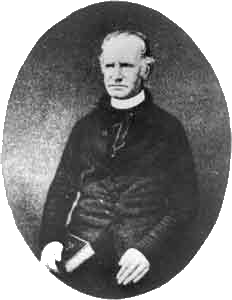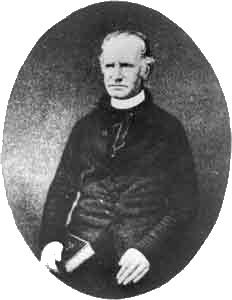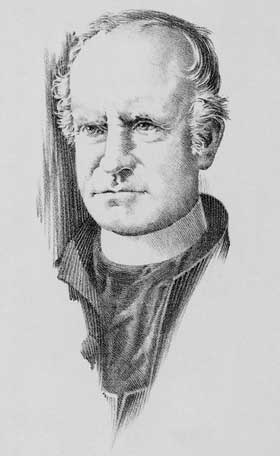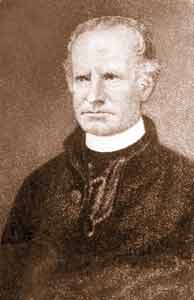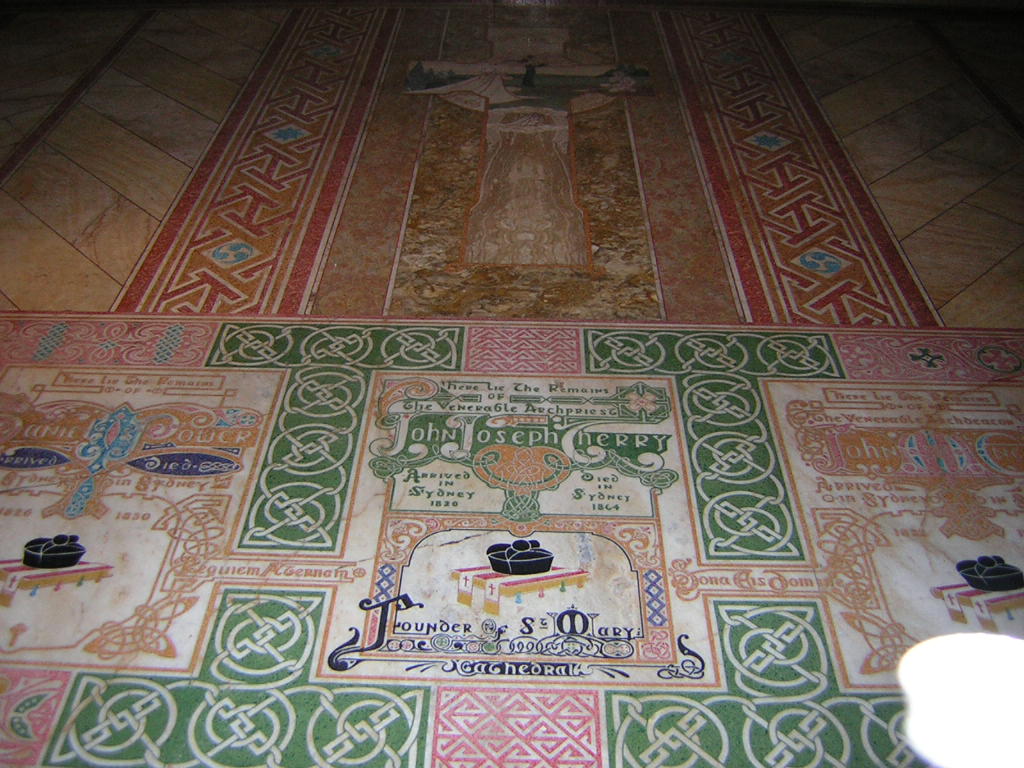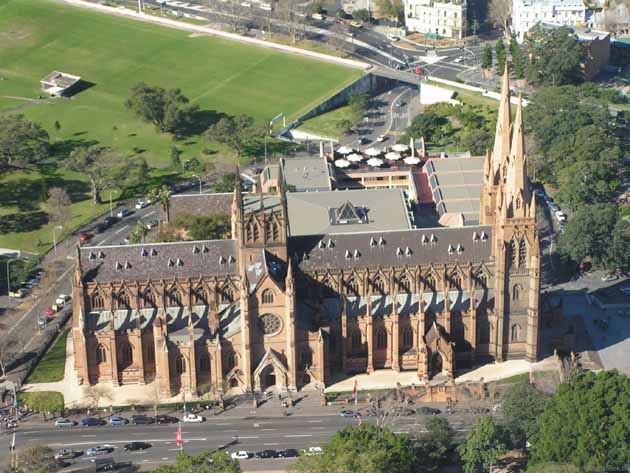Therry was born in Ireland in 1790, to John Therry and his wife Eliza Connolly. His people were in comfortable circumstances and the boy was largely educated by a tutor at home. In 1812, he was at the ecclesiastical college of St. Patrick at Carlow and in 1815, was ordained as a priest. He performed parish work in Dublin and later on as secretary to the Bishop of Cork. He had heard that Catholic convicts in Australia were without a priest to minister to them, and let it be known that he would be willing to go there as a missionary. On December 5, 1819, he sailed on the Janus which carried more than a hundred prisoners with another priest, the Reverend P. Conolly, as a companion. They arrived at Sydney on May 3, 1820. Unlike Father O'Flynn, who had previously arrived without government sanction and had been deported, the two priests were accredited chaplains with a salary from the government of £100 a year each. The two men were of different temperaments and found it difficult to agree and in 1821, Conolly went to Tasmania and remained there until his death in 1839, leaving Therry as the only priest on the mainland for five seminal years.
Therry set about his work with great vigour. His chief anxiety was the need of a church, and in view of the increase in the population of Sydney in future years, it was decided that it should be on a large scale. Almost by chance the site on which St. Mary's Cathedral now stands was granted by the government, subscriptions were given by generous people, including many non-Catholics, and by 1823 it had been agreed that if a fresh subscription were opened the government would give a sum "equal to the sum total of all such additional donations". Governor Macquarie had laid the foundation stone on October 29, 1821. Governor Brisbane, who succeeded Macquarie, was tolerant and helpful, but when Governor Darling arrived in December 1825, a period of anxiety for Therry and his church set in.
In June 1826, Therry sent a letter to colonial secretary McLeay which Darling described as "insulting" when it was sent on to the Colonial Office. It was certainly a tactless letter, and one that could hardly be expected to help Therry in his work. He had been in conflict with Darling before, and in February 1826, Bathurst had sent instructions that his salary should be stopped. Darling had not yet received this dispatch, and he now asked that Therry should be removed. For the next 12 years, until 1857, Therry was without the official status of a government chaplain. Father Power was appointed chaplain, a man in poor health, who was compelled at times to accept assistance from Therry, though the two men were unable to find a way of living amicably together. Power, however, died in March 1830, Therry was again alone, and the government was compelled to countenance his ministrations. He was much helped by a friendship he formed with a namesake, Roger Therry, who arrived in Sydney towards the end of 1829, held many important positions, and became a leading Roman Catholic layman.
In September 1831, Therry was supplanted by the Rev. C.V. Dowling who succeeded Power. Similar difficulties arose, but Darling had left at the end of 1830, and the arrival of the wise and just Governor Bourke gave new hope to the Roman Catholic community. In August 1832, the Rev. John McEncroe came to Sydney and established a friendship with Therry. In February 1833, Father William Bernard Ullathorne arrived and informed Therry that he had come as vicar-general, and Therry at once submitted to his authority. Ullathorne, who was young with a fine grasp of business, was at times critical of Therry's lack of this quality, but realized how truly religious he was and how hard he had worked for his people. In May 1834, John Bede Polding OSB., the first Roman Catholic Bishop in Australia, was appointed and arrived in September 1835. In April 1837, Therry was officially reinstated as a chaplain at a salary of £150 a year, and in April 1838, he arrived at Launceston on a mission to the church in Tasmania. In March 1839, he permanently took up his position in Tasmania as vicar general and worked there with some success.
The arrival of Robert William Willson, first Bishop of Hobart, in May 1844, led to much unhappiness for Therry. Bishop Willson had stipulated before accepting the see that Therry should be recalled from Hobart before his arrival. This was not done and the bishop promptly removed Therry from office. Difficulties also arose concerning the responsibility for church debts, and eventually Therry was suspended from all clerical duties. He remained for two years in Tasmania and in August 1846, was transferred to Melbourne, where he made a reputation for his charity and missionary work. After a fruitless visit to Tasmania, made in the hope of composing his differences with the bishop, he went to Sydney in 1847, and was made priest in charge at Windsor.
In September 1848, he was again in Hobart, and remained for five years, much occupied with matters relating to the disputes over the finances. Early in 1854, he returned to Sydney and in May 1856, again took up parish work at St. Augustine's, Balmain. He seems to have had by now considerable private means, as in August 1856, he gave £2000 to the fund for the completion of the cathedral. Many friendless men had left their small belongings to him, and land granted to him in the early days had become valuable. In 1858, he was raised to the dignity of archpriest, a rank today known as vicar capitular. Simple and unselfish, a firm democrat and a zealous priest, Therry was a man of large notions and considerable achievement. He was an unsophisticated man with no clear ideas of social systems or political reform. Yet his energy and persistence proved a continual source of trouble to those who opposed his ideas of what was right or possible. He died aged 73, on May 25, 1864, after a few hours of illness, working to the last day of his life. In his will, he left a sizeable sum to bring the Irish Jesuits to Australia.
Therry was born in Ireland in 1790, to John Therry and his wife Eliza Connolly. His people were in comfortable circumstances and the boy was largely educated by a tutor at home. In 1812, he was at the ecclesiastical college of St. Patrick at Carlow and in 1815, was ordained as a priest. He performed parish work in Dublin and later on as secretary to the Bishop of Cork. He had heard that Catholic convicts in Australia were without a priest to minister to them, and let it be known that he would be willing to go there as a missionary. On December 5, 1819, he sailed on the Janus which carried more than a hundred prisoners with another priest, the Reverend P. Conolly, as a companion. They arrived at Sydney on May 3, 1820. Unlike Father O'Flynn, who had previously arrived without government sanction and had been deported, the two priests were accredited chaplains with a salary from the government of £100 a year each. The two men were of different temperaments and found it difficult to agree and in 1821, Conolly went to Tasmania and remained there until his death in 1839, leaving Therry as the only priest on the mainland for five seminal years.
Therry set about his work with great vigour. His chief anxiety was the need of a church, and in view of the increase in the population of Sydney in future years, it was decided that it should be on a large scale. Almost by chance the site on which St. Mary's Cathedral now stands was granted by the government, subscriptions were given by generous people, including many non-Catholics, and by 1823 it had been agreed that if a fresh subscription were opened the government would give a sum "equal to the sum total of all such additional donations". Governor Macquarie had laid the foundation stone on October 29, 1821. Governor Brisbane, who succeeded Macquarie, was tolerant and helpful, but when Governor Darling arrived in December 1825, a period of anxiety for Therry and his church set in.
In June 1826, Therry sent a letter to colonial secretary McLeay which Darling described as "insulting" when it was sent on to the Colonial Office. It was certainly a tactless letter, and one that could hardly be expected to help Therry in his work. He had been in conflict with Darling before, and in February 1826, Bathurst had sent instructions that his salary should be stopped. Darling had not yet received this dispatch, and he now asked that Therry should be removed. For the next 12 years, until 1857, Therry was without the official status of a government chaplain. Father Power was appointed chaplain, a man in poor health, who was compelled at times to accept assistance from Therry, though the two men were unable to find a way of living amicably together. Power, however, died in March 1830, Therry was again alone, and the government was compelled to countenance his ministrations. He was much helped by a friendship he formed with a namesake, Roger Therry, who arrived in Sydney towards the end of 1829, held many important positions, and became a leading Roman Catholic layman.
In September 1831, Therry was supplanted by the Rev. C.V. Dowling who succeeded Power. Similar difficulties arose, but Darling had left at the end of 1830, and the arrival of the wise and just Governor Bourke gave new hope to the Roman Catholic community. In August 1832, the Rev. John McEncroe came to Sydney and established a friendship with Therry. In February 1833, Father William Bernard Ullathorne arrived and informed Therry that he had come as vicar-general, and Therry at once submitted to his authority. Ullathorne, who was young with a fine grasp of business, was at times critical of Therry's lack of this quality, but realized how truly religious he was and how hard he had worked for his people. In May 1834, John Bede Polding OSB., the first Roman Catholic Bishop in Australia, was appointed and arrived in September 1835. In April 1837, Therry was officially reinstated as a chaplain at a salary of £150 a year, and in April 1838, he arrived at Launceston on a mission to the church in Tasmania. In March 1839, he permanently took up his position in Tasmania as vicar general and worked there with some success.
The arrival of Robert William Willson, first Bishop of Hobart, in May 1844, led to much unhappiness for Therry. Bishop Willson had stipulated before accepting the see that Therry should be recalled from Hobart before his arrival. This was not done and the bishop promptly removed Therry from office. Difficulties also arose concerning the responsibility for church debts, and eventually Therry was suspended from all clerical duties. He remained for two years in Tasmania and in August 1846, was transferred to Melbourne, where he made a reputation for his charity and missionary work. After a fruitless visit to Tasmania, made in the hope of composing his differences with the bishop, he went to Sydney in 1847, and was made priest in charge at Windsor.
In September 1848, he was again in Hobart, and remained for five years, much occupied with matters relating to the disputes over the finances. Early in 1854, he returned to Sydney and in May 1856, again took up parish work at St. Augustine's, Balmain. He seems to have had by now considerable private means, as in August 1856, he gave £2000 to the fund for the completion of the cathedral. Many friendless men had left their small belongings to him, and land granted to him in the early days had become valuable. In 1858, he was raised to the dignity of archpriest, a rank today known as vicar capitular. Simple and unselfish, a firm democrat and a zealous priest, Therry was a man of large notions and considerable achievement. He was an unsophisticated man with no clear ideas of social systems or political reform. Yet his energy and persistence proved a continual source of trouble to those who opposed his ideas of what was right or possible. He died aged 73, on May 25, 1864, after a few hours of illness, working to the last day of his life. In his will, he left a sizeable sum to bring the Irish Jesuits to Australia.
Inscription
Very Rev. John Joseph Therry, Archpriest, departed this life 25th of May, 1864, aged 74 years. R.I.P.
Advertisement
Advertisement
